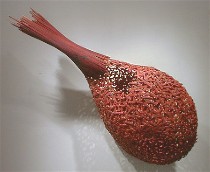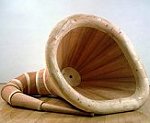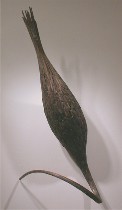 Fritz Dietel has done something unexpected (to me) in this latest show at Schmidt/Dean Gallery. He’s added what Eva Hesse called “ick.”
Fritz Dietel has done something unexpected (to me) in this latest show at Schmidt/Dean Gallery. He’s added what Eva Hesse called “ick.”
What’s startling about this is that Dietel is a craftsman’s craftsman, a poet in wood, whose work is so pristine, “ick” would likely not be an option.
 But somehow, this time he has merged the two aesthetics, adding pigmented epoxy, colors straight from the crayola box–purple, orange, teal, yellow, etc.–to his wooden cocoon’s and husks.
But somehow, this time he has merged the two aesthetics, adding pigmented epoxy, colors straight from the crayola box–purple, orange, teal, yellow, etc.–to his wooden cocoon’s and husks.
The epoxy in some of the pieces makes me think of pitch rubbed into the interior of baskets for waterproofing (see “Yellow Hive” left) and in some of the pieces it looks like globs of glue, as in the orange comet-like “Bivouac” (shown, made of oak and cedar), in which the epoxy in the baskety pouch is orangy globs gluing together the little chunks of wood.
 In this shift to ick, I am reminded of the superb Martin Puryear, also a master of wood forms, who used tar, and went further in the degree of ickiness. But Puryear (his “Horn” shown here) is more about society and cultural issues, and tar had racial content.
In this shift to ick, I am reminded of the superb Martin Puryear, also a master of wood forms, who used tar, and went further in the degree of ickiness. But Puryear (his “Horn” shown here) is more about society and cultural issues, and tar had racial content.
 In Dietel’s work, we’re in the land of baskets without weave or purpose; of sea creatures, insects, scorpions; of containers that do not really contain, with chinks, narrow mouths, often narrow exit openings; of the space inside and its relationship to the space outside; and of the pattern and poetry of the wood, including its colors and its historic uses.
In Dietel’s work, we’re in the land of baskets without weave or purpose; of sea creatures, insects, scorpions; of containers that do not really contain, with chinks, narrow mouths, often narrow exit openings; of the space inside and its relationship to the space outside; and of the pattern and poetry of the wood, including its colors and its historic uses.









